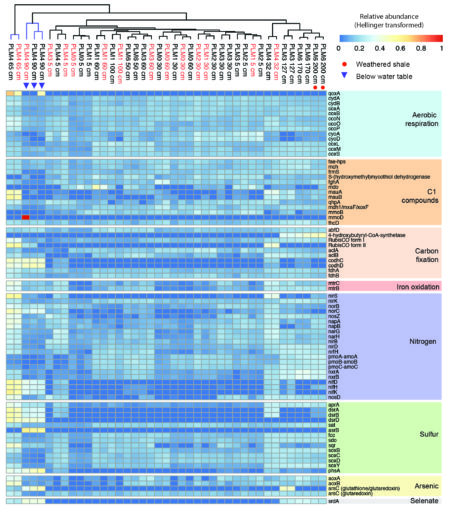
Spatial abundance of genes central to metabolic pathways. Samples from the floodplain (blue colored clade) are distinct from samples of the hillslope (black colored clade), particularly with respect to carbon fixation and selenate reduction. Furthermore, weathered shale samples at PLM6 are distinct from other hillslope samples.
Based on a hillslope to riparian zone transect study, the distance from surface water, the proximity to groundwater, and the underlying weathered shale were found to strongly impact microbial community structure and metabolic potential. Microbes from Candidate phyla were found to consistently increase in abundance with increasing depth; however, Candidate Phyla Radiation bacteria were only found in the riparian zone saturated sediments.
The results of this work demonstrate that riparian zone and deep soil microbial communities are functionally differentiated from shallow hillslope communities based on their metabolic capacity. These findings suggest that the drivers of community composition and metabolic potential identified along this representative hillslope-to-floodplain transect will be key for predicting patterns across similar such transects within mountainous systems.
Summary
Within mountainous watersheds, microbial communities impact water chemistry and element fluxes as water from precipitation events discharges through soils and underlying weathered rock; however, there is limited information regarding the structure and function of these communities. Within the East River, CO watershed, a team of scientists conducted a depth-resolved, hillslope to riparian zone transect study to identify factors that control how microorganisms and their functionality are distributed. Metagenomic and geochemical analyses indicate that distance from the East River and proximity to groundwater and underlying weathered shale strongly impact microbial community structure and metabolic potential. Riparian zone microbial communities are compositionally distinct from the phylum to species level from all hillslope communities. Bacteria from phyla lacking isolated representatives were found to consistently increase in abundance with increasing depth, but Candidate Phyla Radiation bacteria were only found in the riparian zone saturated sediments. Riparian zone microbial communities were found to be functionally differentiated from hillslope communities based on their capacities for carbon and nitrogen fixation and sulfate reduction. Selenium reduction was found to be prominent at depth in weathered shale and saturated riparian zone sediments and could impact water quality. The results suggest that the drivers of community composition and metabolic potential identified throughout the studied transect would be key for predicting patterns across the larger watershed hillslope system.
Citation
Lavy A., McGrath D. G., Matheus Carnevali P. B., Wan J., Dong W., Tokunaga T. K., Thomas B. C., Williams K. H., Hubbard S. S., Banfield J. F. (2019) Microbial communities across a hillslope-riparian transect shaped by proximity to the stream, groundwater table, and weathered bedrock. Ecology and Evolution. DOI: 10.1002/ece3.5254
